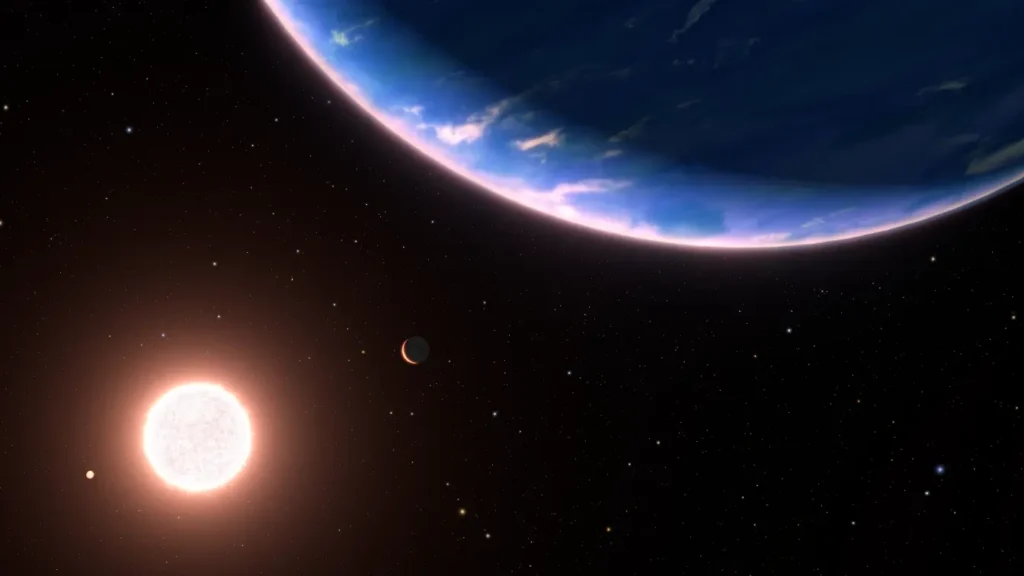NASA’s Hubble Space Telescope, a beacon of scientific exploration, has once again astounded astronomers and space enthusiasts alike by uncovering water vapor in the atmosphere of exoplanet GJ 9827d. In this article, we’ll delve into the profound implications of this discovery and explore the broader context of exoplanetary research.
What is GJ 9827d?
GJ 9827d, a distant exoplanet located in a distant corner of our galaxy, is not merely a celestial body; it represents a gateway to understanding the mysteries of the universe. With characteristics that set it apart, such as its size, composition, and distance from its host star, GJ 9827d has become a focal point of scientific curiosity.
The Role of NASA’s Hubble Space Telescope
The Hubble Space Telescope, orbiting our planet since 1990, plays a pivotal role in advancing our understanding of the cosmos. Equipped with state-of-the-art technology, Hubble’s ability to detect water vapor in exoplanets has opened new avenues for exoplanetary research, allowing scientists to explore the atmospheres of these distant worlds.
Water Vapor Discovery: Implications and Findings
The discovery of water vapor on GJ 9827d holds profound scientific significance. It not only hints at the potential habitability of exoplanets but also provides valuable insights into the conditions necessary for life beyond our solar system. Comparisons with other exoplanets enhance our understanding of the diverse atmospheres that exist in our galaxy.
Understanding Exoplanets and Their Atmospheres
To comprehend the significance of the Hubble discovery, it’s crucial to have a basic understanding of exoplanets. These planets, located outside our solar system, vary widely in size, composition, and atmospheric conditions. The atmospheres of exoplanets, including the presence of water vapor, are key indicators of their potential habitability.
Breakthrough Technologies in Astronomy
Advancements in telescope technology have propelled astronomical discoveries to new heights. The Hubble Space Telescope represents a testament to human ingenuity, showcasing how breakthroughs in technology contribute to our understanding of the cosmos. The ongoing evolution of space exploration technologies promises even more profound revelations in the future.
GJ 9827d in the Context of Space Exploration
Placing GJ 9827d in the broader context of space exploration reveals the vastness of our galaxy and the countless celestial bodies awaiting discovery. This exoplanet joins the ranks of other notable discoveries, each contributing to our expanding knowledge of the universe.
Public Excitement and Interest
The announcement of water vapor on GJ 9827d has sparked widespread excitement on social media platforms. People from all walks of life express fascination with the cosmos, highlighting the universal appeal of space exploration. This collective interest further underscores the importance of scientific communication and education.
Challenges and Future Research
Despite the advancements in technology, studying exoplanets presents considerable challenges. The vast distances, complex atmospheres, and limited observational windows make exoplanetary research a demanding endeavor. However, ongoing missions and emerging technologies hold promise for overcoming these challenges and unveiling even more celestial secrets.
How Discoveries Impact Our View of the Universe
Each discovery in the realm of space exploration expands our understanding of the universe. GJ 9827d’s water vapor revelation prompts contemplation about the potential diversity of habitable environments and the prevalence of life in the cosmos. The ongoing quest for knowledge shapes our collective perspective on our place in the universe.
In conclusion, the detection of water vapor on GJ 9827d by NASA’s Hubble Space Telescope marks another milestone in our exploration of the cosmos. This discovery not only adds a new layer to our understanding of exoplanets but also fuels our curiosity about the broader mysteries of the universe. As technology advances and missions to study exoplanets intensify, the future promises even more awe-inspiring revelations.
FAQs
1. How does NASA’s Hubble Space Telescope detect water vapor in exoplanets?
- NASA’s Hubble detects water vapor through the analysis of light passing through the exoplanet’s atmosphere. By examining specific wavelengths, scientists can identify the unique signature of water molecules.
2. What makes GJ 9827d unique among exoplanets?
- GJ 9827d stands out due to its specific characteristics, including size, composition, and distance from its host star. These features contribute to its significance in the realm of exoplanetary research.
3. Are there other exoplanets with water vapor in their atmospheres?
- Yes, scientists have detected water vapor in the atmospheres of several exoplanets. Each discovery adds to our understanding of the potential habitability of these distant worlds.
4. How do breakthroughs in space exploration technology impact scientific understanding?
- Breakthroughs in technology, such as advancements in telescope capabilities, enable scientists to make unprecedented observations and gather data that enhance our understanding of the cosmos.
5. What challenges does exoplanetary research face, and how are they being addressed?
- Challenges in exoplanetary research include vast distances, complex atmospheres, and limited observational opportunities. Ongoing missions and emerging technologies aim to overcome these challenges for more comprehensive exploration.







